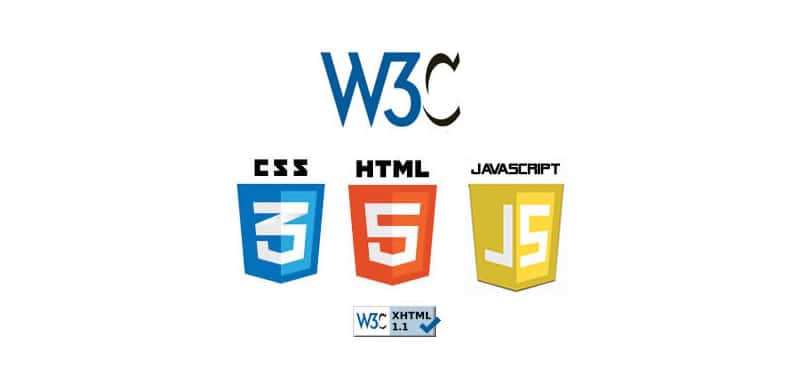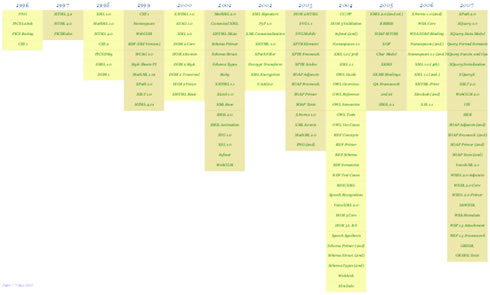W3C Web Standards - What are standards, how do they work?
They are Web languages, protocols, guidelines and inter-operative and international technologies created with the purpose of guiding the Web to its maximum potential.

What are Web standards?
They are Web languages, protocols and inter-operative and international technologies created with the purpose of guiding the Web towards its maximum potential through the development of standardized protocols and guidelines.
In order for the Web to reach its maximum potential, the most prominent Web technologies must be compatible with each other and allow any hardware and software to access the Web to work together.
W3C refers to this objective as "Web interoperability"
Why do I need Web standards?
- Have you ever visited a Website and could not see the contents correctly?
- Do you use an Internet browser such as Mozilla Firefox, Opera or Safari different from the majority one (Internet Explorer) and you are tired of seeing that the elements of the website do not look or work properly?
- Do you have vision problems and can not change the font size because the pages are broken or look bad?
Well, if this has ever happened to you and it was quite annoying, think now that you are a visitor to your own website ...
The most logical thing is that you have just lost a potential client without even having the possibility of offering your services or articles and that you may not visit your website again.
What is a Standard?
A standard is a set of formerly planned rules that describe the requirements that must be met by a product, process or service, with the aim of establishing a base mechanism to allow different hardware or software elements that use it to be compatible with each other.
W3C, an independent and neutral organization, develops Web-related standards also known as Recommendations, which serve as a reference to build an accessible, interoperable and efficient Web, in which more robust applications can be developed.
What is W3C?
The World Wide Web Consortium (W3C) is an international community where Member organizations, full-time staff and the general public work together to develop Web standards.
Led by Web inventor Tim Berners-Lee and CEO Jeffrey Jaffe, W3C's mission is to guide the Web to its full potential.
Who participates in the creation of W3C recommendations?
Its Members participate (more than 400 organizations, distributed throughout the world and from different areas: large hardware or software companies, research centers, universities, public administrations, etc.), the W3C Team, invited experts, and any user of the Web who wants to express his opinion.
The result: more than 110 technologies since 1996.

What are they for?
The purpose of the standards is the creation of a universal, accessible, easy to use website that everyone can trust.
With these open and free-use technologies, we intend to avoid the fragmentation of the Web and improve the infrastructures so that we can evolve towards a Web with the best organized information.
How does a standard work?
The creation of a standard requires a controlled process in which specialists in the field ensure quality by refining the specifications before recommending them in the W3C.

The best known and widely used Web standards are: HTML (HyperText Markup Language), XML (eXtensible Markup Language) and CSS (Cascading Style Sheets).
Web standards checklist
Code quality
- Does the site use a correct Doctype?
- Does the site use valid HTML code?
- Does the site use valid CSS code?
- Does the site use unnecessary 'classes' or 'ids' ?
- Is the code well structured?
- Does the site contain a broken link?
- How does the site respond in terms of speed and weight of its pages?
- Does the site have JavaScript errors?
Degree of separation between content and its presentation
- Do you use the CSS site for all aspects of the presentation (typography, colors, margins, borders, etc.)?
- Are all the decorative images within the CSS code, or do they appear in the HTML code?
Accessibility for users
- Are the "alt" attributes used for all descriptive images?
- Does the site use relative units instead of absolute ones for the size of the text?
- Does the site use visible menus?
- Does the site use accessible forms?
- Does the site use accessible tables?
- Are there enough brightness / contrasts of color?
- Is there a delay in the response of dropdown menus (for users with reduced motor skills)?
- Are all the descriptive links (for blind users)?
Accessibility for devices
- Does the site work acceptably in modern and older browsers?
- Is content accessible with CSS disabled or not supported?
- Does the site work in text browsers?
- Is the site useful to send to print?
- Does the site work well on mobile devices?
- Does the site include detailed Tags?
- Does the site work well in the different sizes of the browser window?
Basic Usability
- Is there a clear visual hierarchy?
- Are the header levels easy to distinguish?
- Does the site have an easy navigation to understand?
- Does the site use consistent navigation?
- Are the links underlined?
- Do you have a map site and a contact page? Are they easy to find?
- Is there a search tool?
- Is there a link to the main or home page on each page of the site?
- Are the links visited clearly defined with a unique color?
Site management
- Does the site have a 404 error page and significant help on the site?
- Does the site use friendly URLs?
- Do your URLs work without "www"?
The future of the Standards
Some standards are going profiling on the Web
More than standards, they are aspects that predominate in successful web projects.
- Areas that require registration
- Advertising in text format
- Break the header effect
- Elimination of fixed areas of navigation
- Related navigation
- Very high download speed
- Dynamic drop-down menus do not work
- Welcome pages and choice of language
- Blue and underlined links
- Do not launch content in new windows
CITE ARTICLE
For homework, research, thesis, books, magazines, blogs or academic articles
APA Format Reference:
Delgado, Hugo. (2019).
W3C Web Standards - What are standards, how do they work?.
Retrieved Nov 22, 2025, from
https://disenowebakus.net/en/web-standards






